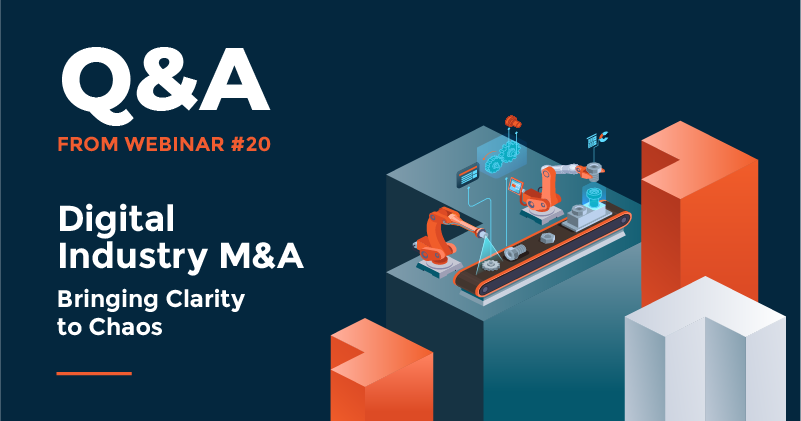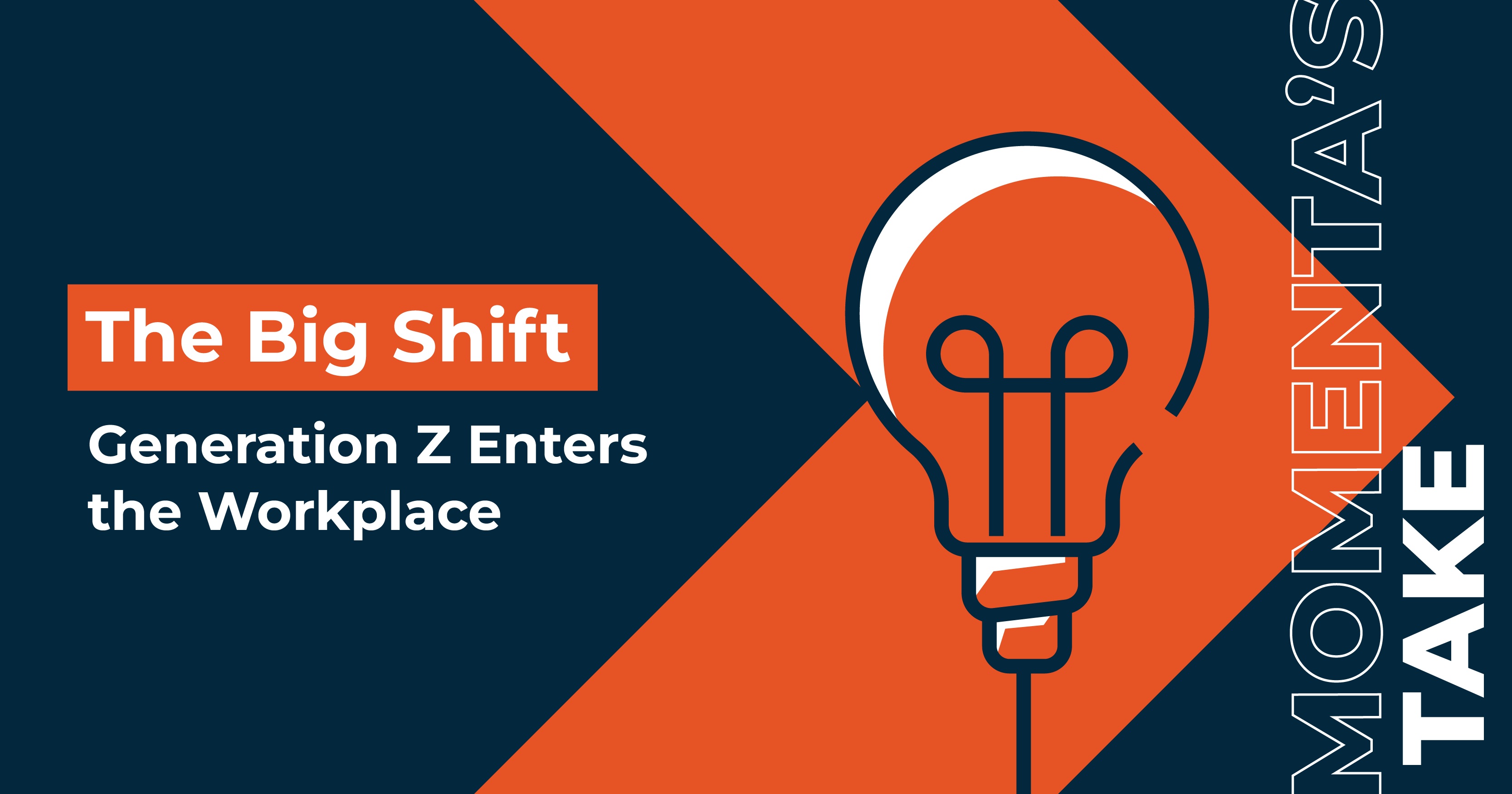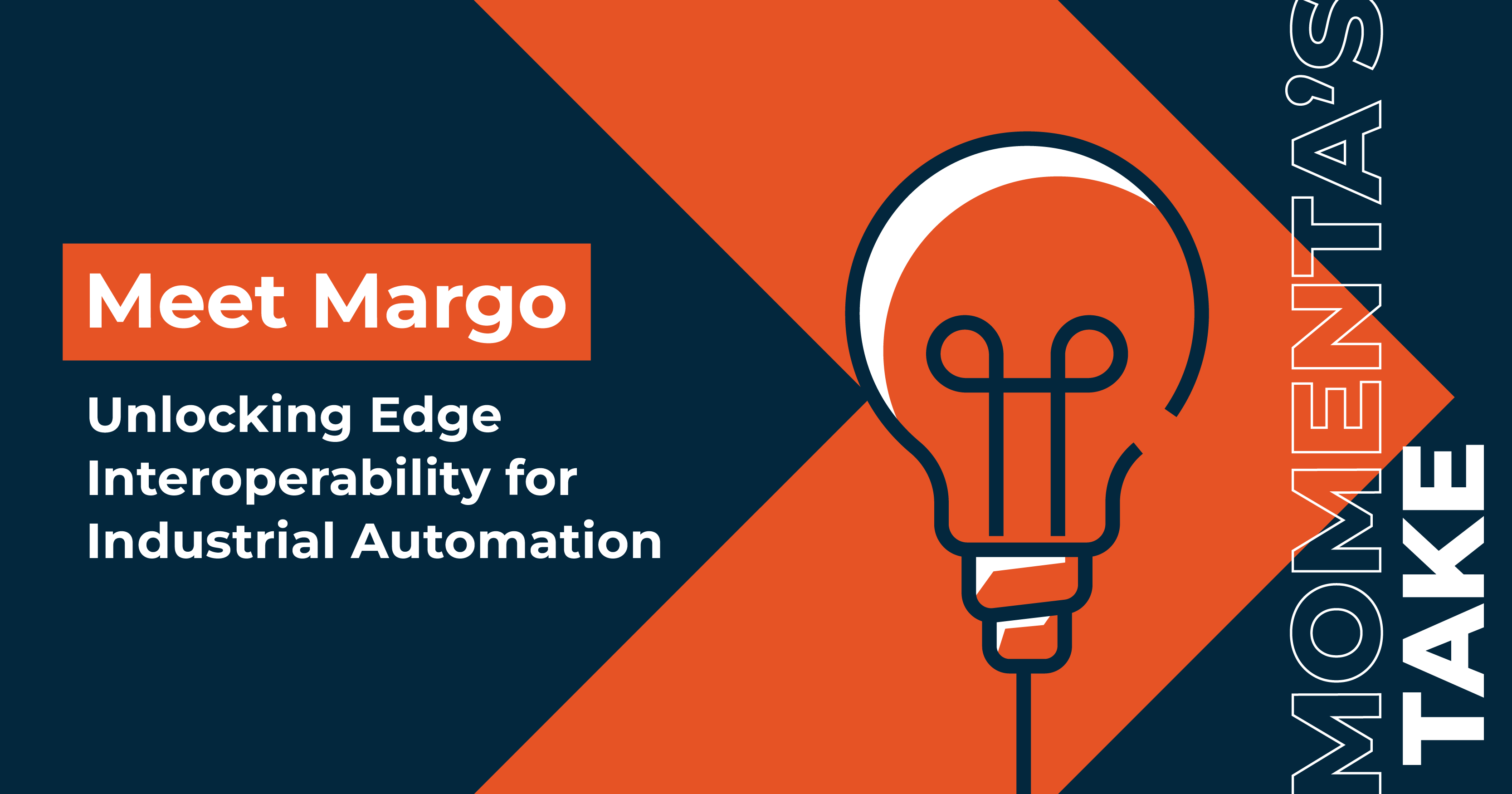Answers to Your Questions on Digital Industry M&A
Doug Harp

Due to the amount of high caliber questions that were asked during our live webinar event Digital Industry M&A - Bringing Clarity to Chaos, we put together a summary to answer all of your inquiries.
Ben: What is the panel's thoughts on using deep learning type technology more in M&A and any areas of focus - pre-deal, deal, post deal merger?
Over time, I have seen the M&A industries that are actively embracing new technologies especially in the areas of curating and disseminating information to better connect buyers and sellers as well as automating the digital industry M&A process. I have not seen deep learning technologies applied specifically, but I did see innovative startups beginning to add more human intelligence to the due diligence process. For example, it is a labor-intensive process to dig out the small piece of insights from data room’s hundreds of legal, financial and customer contracts. Some startups are trying to create an intelligent data room, whose role is no longer to just surface the documents to the reviewers but the insights behind those documents. Could deep learning be applicable there – absolutely!
Bill: In the “Digital World”, which is the sub-market that you see as the most interesting post COVID-19 (AI, Big Data, Cybersecurity, IoT, etc.)?
I’m going to focus on the Digital Industry M&A (vs. the broad digital world). In this market, COVID is going to accelerate areas that enable business to not be disrupted by the next pandemic (or even this one). Certainly AR/VR and remote sensing will be key so one can do remote audits, remote monitoring without having to visit a site. I also believe Robotics will become a critical element of the industrial “reboot”. Finally, Edge computing and sensing (e.g. fever detection) will become important for the new world post-COVID.
Ben: What do you expect in terms of valuations (or multiples)? Are they going to increase/decrease/stable?
Private market valuation is heavily influenced by public market behavior and is often positively correlated across a full range of market scenarios. Given the COVID crisis, a lot of organizations are in the cash preservation model – startups want to save cash now that fund raising is taking longer, VC firms are saving the cash for its existing portfolio companies, LPs are finding their own fund sources whether from university endowments or pension funds to be shrinking. I do see the valuation coming down but from a historically high level. Strategic investors will still get deals done at fair price as they have more levers to generate positive returns.
Ben: What will be the biggest difference in deal making in a post-pandemic world?
Think of the pandemic as a major pressure test. Some of the bubbles and excess investments will be squeezed out a couple of years ahead of schedule. The stronger businesses will endure the challenge and emerge stronger, as they have a less fragmented market, more choices of high-quality employees and also as customers seek to become more careful in selecting the vendors that could stay, the stronger ones will benefit from that as well. For deal makers, they will be under more scrutiny to get a higher return from M&A dollars. I expect a smaller number of higher quality deals will be done as well.
Bill: What is your view on logistics and warehouse market automation?
One core driver will be centralized data (vs. siloed data). Momenta has put together a “point of view” on this with a breakdown of the various transformation that will occur. A key element is the transformation of sequential, siloed data into central data driving real-time visibility across the supply chain. Specifically, in warehouse automation the combination of robotics and asset tracking is already transforming that area and when you combine that with the above you will see the continued transformation of today’s supply chain.
Ben: What about PTC acquiring Onshape?
It is a very strategic move not only for PTC, but also for the CAD industry. Engineering software is one of the last strongholds where multi-tenant SaaS has not penetrated for many reasons, from user behavior to sensitivity of engineering IP to the highly complex CAD data model to get it right to deliver a Google doc type of online experience. Onshape is the only company that managed to do that successfully. PTC paid a big premium to do it. PTC has a lock of a big share of the install base. Onshape is a revolutionary technology and shaves years of catch-up work PTC would need to do without this deal.
Stefan: On Slide 20, Realizing Deal Value, is "pre-deal value" only the intrinsic enterprise value of the acquired company, or do you include other elements in that?
The diagram is illustrative to provide the big picture of corporate value. When in an acquisition integration setting, the approach is to quantify cost and revenue synergies and related costs to achieve that can be planned for and tracked during the integration. Not typically quantified financially (in term of dollars or equivalent currency) is employee or customer attrition and decrease in corporate performance - however, these areas do have identified metrics that are tracked and have related tasks during an integration with a focus on mitigating risk.
Ben: Have you observed any common characteristics which have made s/w startups and target technology companies more attractive in the search phase more successful in the integration phase that can be developed during pre-M&A period?
There is a simple truth about software startups – it is a people business. No inventory, no supply chain, often very little cost of goods sold outside of professional services. A lot of integration failures were people problems. When founders are feeling disenfranchised and counting their two-year exit clock vs. doing what they claim wanting to do – join a bigger company to accelerate and broaden their vision. You have a failed integration in the making. I would say one thing you can do is to really put yourself into the shoes of the founder, understand their motivations, see from their eyes how all the goals you want to achieve will appeal to them, even when their personal financial situation will be dramatically altered by the deal. It is not an easy thing to do, but if you should at least try doing it and building experience along the way!
What are the changes in value drivers in a post-COVID scenario?
Stefan: Generally, I expect there will be increased emphasis to roll-up distressed companies that may have been valued higher pre-COVID-19. I do believe there will be more strategic plays in industries that are significantly impacted. Will digital industry solutions have more impact in meat packing for instance? How will casinos, cruise ships, air travel, etc. change and what digital transformations can occur to rebuild these specific industries? Will COVID-19 further increase the need for automation and how will this impact acquisition strategy? These are areas that will be of future emphasis.
Bill: To add to Stefan, deal value drivers will include resilience of the business to the next pandemic. These could be exclusively around the target or more importantly the synergy between the acquirer and the target and identifying metrics to track that.
Ben: Can you speak to valuations for software companies in the industrial space. Why do they warrant higher revenue multiples (in some cases) than pure Enterprise or consumer SaaS? How can that value be clearly identified when the target company is often unprofitable and may be looking at a revenue multiple that seems extremely high, for instance, over 10x.
Valuation of a company is based on market supply and demand at the macro level and the individual target’s intrinsic strength at the micro level. That balance shifts dramatically as the industry matures. At the beginning, the more savvy investors spotted a trend and got in with the right target at the low multiple, later on, more investors will enter the market – if the entry barrier is high, they will bid up the price. I don’t think industrial space is a guarantee of high valuation, some investors are concerned about scalability and the last mile issue we discussed during the Webinar actually avoids the space as a whole. Some pure consumer SaaS still fetch very high multiples. Value is in the eye of beholders. For unprofitable companies, it is important to understand why it is unprofitable and what is your playbook under your ownership. Expensive or not is always a relative question, relative to your strategy, your competitive position, and your financial/organizational capability to implement your strategy.
Bill: What is a good strategy for a Small Business (<$2M YR) to gain access to companies that are open to being acquired? We are looking to grow our IoT subscription services. Sorry for a basic question, but us small companies that have cash and want to grow. Thank you.
I think you make a good point that a core way to scale is by acquiring synergistic small companies. It is interesting to read the GitLab site which is very transparent about the companies they are looking for. That is a challenging question as the Investment Bankers I know focus on big targets. One could take that approach and be transparent, if you are comfortable with that, on your website and directly source your deals. The other is to approach early stage VC funds that are aligned with your targets and have a discussion with that team. The other is attending networking events in your target area and ask that question of targeted companies. Finally, if you have access to Pitchbook or other tools, you can search for those companies and identify ones that might be ready to exit. The bottom line is to start with a strategy focused on what type of companies provide the synergy you are looking for.
Ben: Beyond market, customers, and technology - what is your experience and how does one evaluate the human capital of potential acquisitions?
Before evaluating human capital, it is important to establish what you are looking for, which should be tied up with your overall investment theses. For technology tuck-ins, your focus will be on product talents, for new market entry, you need a retention plan for your market facing people. For a new business model, you want to make sure the company has a great culture that could jumpstart your own culture 2.0 through this acquisition. There is no uniform formula. The whole diligence process is not a cookie cutter business.
Bill: As a startup, what should we do to make ourselves an attractive acquisition target?
In many ways it is like preparing anything for sale. Make sure your books are all in order. Go through a typical due diligence list and get your information organized. Create a one page “teaser” that describes the company in a general way and a 9-10 page Confidential Information Memorandum (CIM). In many ways similar to a pitch deck but putting the content in eyes of an acquirer. Finally, create a list of acquirers including any strategic partners that you’ll approach with the teaser then the CIM. Position yourself from their eyes and their strategy so you help them “connect the dots”. If this is too challenging, you’ll need to hire an advisor and/or investment banker.
Ben: With reference to the belief that firms have significant 'dry powder' available to invest - what is the key driver that supports a potential flood of M&A transactions for 2020, given that digital transformation is revolutionizing methodologies in a number of industries?
Jury is still out whether 2020 deal volume will be higher than previous years. The current deal environment does not support that view with a big percentage of deal parties maintaining a wait and see posture. Longer term, there is no doubt, as many of the earlier digital startups scale up, and digital transformation efforts start to take root, with strategic and financial buyers become more seasoned in their acquisition criteria and comfortable taking bigger bets, I do see the deal volume in the industrial space will increase. At Momenta, we are advising both industrial companies and startups, part of our reason for being is to make sure the pace of evolution is much more accelerated to generate outcome for the entire value chain.
Bill: What is OT?
OT is Operational Technology and is the “complement” to IT. Many companies fall into either OT or IT bucket and few bridge it well. More specifically, it is the combination of hardware and software that detects issues and/or causes a change via direct monitoring and/or control of industrial processes, equipment, assets and events.
Bill: Aren't all of the referenced examples focused on perpetuating the "central brain" approach that has been the architecture for OT since the 60's? Is there any appetite/activity around using more autonomous sensors to push more intelligence to the edge?
That is partially true. The combination of Microsoft with Express Logic is more about the continuity of compute from cloud to edge. I’d expect Microsoft to leverage that in the future. Another example you remind me of is Siemen’s acquisition of Pixeom which allows one to run the same application on edge as one does in the cloud. I’m a firm believer in edge computing but it is important to ensure edge and cloud work together instead of writing a whole different application for the edge. Further, synergies between vision and edge computing are already driving some excellent transformation being accelerated by startups such as Smartex.
Ben: Valuation question: How will financial metrics change in the digital sphere post coronavirus? Implication on multiples, WACC and broader metric choice. EBITDA or sales or cash?
I answered part of this in an earlier question. I do see valuation will come down as a function of the overall market, but digital among all sectors are perhaps the least impacted. It will stage a comeback as we fixed the underlying root cause, such as the development of a vaccine or an effective treatment to contain the virus spread. I don’t think the virus will change the choice of metrics, which is closely related to the target’s intrinsic maturity and deal type.
Stefan: Stefan mentioned that ECO partners is a favorable way to accelerate the digital roadmap. What kind if matrix to evaluate and safeguard is he recommending to use when on boarding partners in a ecosystem other than strategic fit or filling a technology gap?
I am not sure if this is talking about bringing in advisory partners or addressing targets to acquire outside of a strategic fit or technology gap. One area is that there may be benefits in bringing on experts via an acqui-hire to establish experts in the field. Also, from a global perspective, it may be considered to acquire firms in new regions to establish a beachhead, such as a Chinese firm making acquisitions or JVs in the US and Europe and vice versa.
As far as bringing on advisory partners or supporting consultants, to address acquisition integration specifically, it is ideal to use qualified internal resources first, but consultants do have a role at the right time. If of interest, review my article: 6 Reasons for Hiring (and Not Hiring) M&A Integration Consultants.
Do you have any additional questions? If so, please contact our Advisory Team who will follow up with you immediately at pema@momenta.one .
__________
Our global team of 25+ has led digital companies and business lines at GE Digital, IBM, PTC, Syngenta and others. Since 2012, we’ve been advisors to the largest Industrial IoT transactions, placed over 200+ leaders, and invested behind 40+ disruptors, including exits to SAP and PTC.



